The Effectiveness of the Webinar in Providing Non-Traumatic Urology Emergencies Education to Medical Personnel during Covid-19 Pandemic
Author'(s): Kurnia Penta Seputra, Medianto, Hamdan Yuwafi Naim, Muhammad Adi S. L and Besut Daryanto*
Department of Urology, Faculty of Medicine, Universitas Brawijaya, Saiful Anwar General Hospital, Malang, East Java,Indonesia.
*Correspondence:
Besut Daryanto, Department of Urology, Faculty of Medicine,Universities Brawijaya, Saiful Anwar General Hospital, Malang,East Java, Indonesia.
Received: 18 February 2021; Accepted: 04 March 2021
Citation: Seputra KP, Medianto, Naim HY, et al. The Effectiveness of the Webinar in Providing Non-Traumatic Urology Emergencies Education to Medical Personnel during Covid-19 Pandemic. Cancer Sci Res. 2021; 4(1): 1-5.
Abstract
Objective: This study assessed the effectiveness of webinar as a medium to provide information and education in the field of non-traumatic urology emergencies.
Methods: A descriptive analytic research design with cross sectional approach was conducted for all participants. The learning outcomes were assessed by comparing the pretest and the posttest.
Result: A total of 775 participants were included in this study. It showed a significant improvement in average score from pre-test to post-test (p<0.000). It also showed a similar result in almost all of the topics with p<0.005, except for the topic of treatment of urinary retention with p=0.434.
Conclusion: The webinar should be considered as one of the effective educational media to provide information and education on non-traumatic urology emergencies for medical personnel during COVID-19 pandemic.
Keywords
Introduction
Basic emergency knowledge is a very important skill for medical personnel as delays in treatment in emergencies could lead to permanent damage and increase the morbidity and mortality of the patients [1]. One of the emergency cases is a non-traumatic urological emergency, which includes acute scrotum, urosepsis, urinary retention, and colic pain. These cases occur quite often in patients admitted to the emergency room (ER). Therefore, in order to prevent permanent damage to the patients and improve the outcome of the treatment, the general practitioner should be proficient with updated information to diagnose the cases effectively and conduct the initial management of emergency urology cases. Providing medical information and education is the new challenge in the COVID-19 pandemic situation. Almost all of the education and knowledge transfer, including in medical education, is experiencing a transformative change amidst the COVID-19 pandemic. With social distancing measures, educators have been transitioned from offline teaching to web-based and online teaching [2-6]. Given the unknown time of how long the pandemic will last, immediate adaptations to the medical curriculum are being made and evaluated to maintain a high quality education [7].
In this study, we assessed the effectiveness of webinar as an educational and informational media in the field of non-traumatic urology emergencies in the COVID-19 pandemic situation, especially for general practitioners. We hypothesized that webinar would be effective as knowledge transfer media in this current pandemic situation based on the correlation of pre and post-test results.
Method
A single-group of pre–post study design was used to evaluate the effectiveness of the webinar in providing non-traumatic urological emergencies education to medical personnel during COVID-19 pandemic situation. The webinar provided information in four topics of non-traumatic urological emergencies: (1) acute scrotum,(2) urosepsis, (3) urinary retention, and (4) colic pain.
This study’s approach is cross-sectional descriptive-analytic. A total of 775 webinar participants were included in this research. We compared their results of the pre-post test scores with consideration on their age, gender, type of occupation, type of health care, year of graduation, and type of medical school.
The content of pre-post test questions were validated both by the urology experts where the study was conducted and the general practitioners receiving the education. Data were collected on December 5 2020.
The webinars were lectured by urologists (surgical specialists) with a duration of 20 minutes each session consisting of a lecture and Q&A session. A pre-test was given prior to the webinars and a post-test was conducted immediately after all sessions on the same day.
Result
A total of 775 webinar participants were included in this study. All participants were asked to fill out the pre-webinar and the post-webinar survey. Half of the participants were female (50.5%) (Figure 1). The average age of participants was 31.8 ± 9.9, with the youngest participant was 18 years old and the oldest was 68 years old. Most of the participants were general practitioners (85.8%). Details on the age, gender, occupation, type of health care, year of graduation, type of medical school are provided in the supporting information data (Table1).
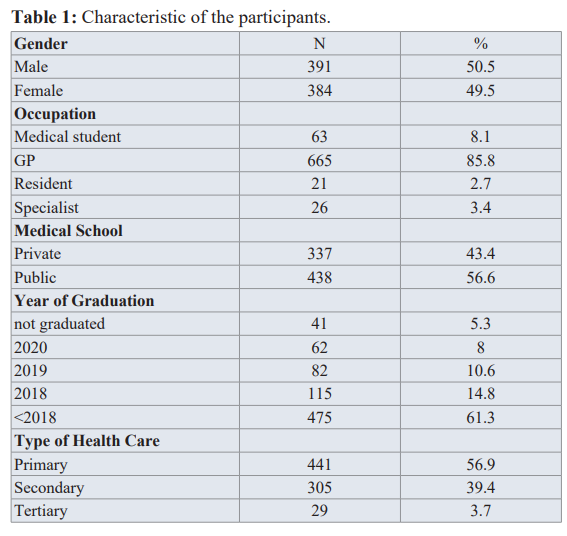
The average score of the pre-test was 75.4 ± 17.3 with the lowest score on the pre-test at 10/100 and the highest at 100/100. On the other hand, the average score of the post-test was 91.3 ± 11.5 with the lowest score on the post-test at 20/100 and the highest at 100/100. Based on the results of pre-test and post-test, the average score of improvement from pre-test to post-test was found to be 15.9 ± 5.8. This number is statistically significant (p<0.001) (Figure 1).
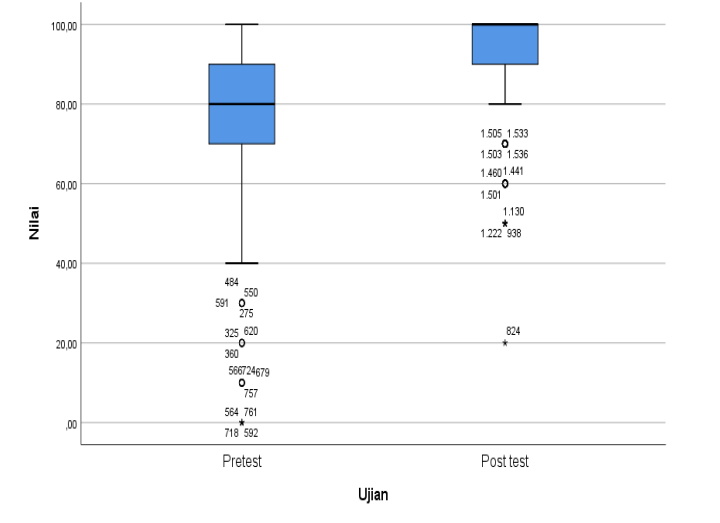
Figure 1: Overall Pretest Vs Posttest Score.
Furthermore, each topic of non-traumatic urological emergency cases including the acute scrotum, urosepsis, urinary retention, and ureteral colic was assessed in this study. For acute scrotum, there were significant differences between pre and post-test score on diagnosis and treatment sub-topic (p<0.001) (Figure 2).
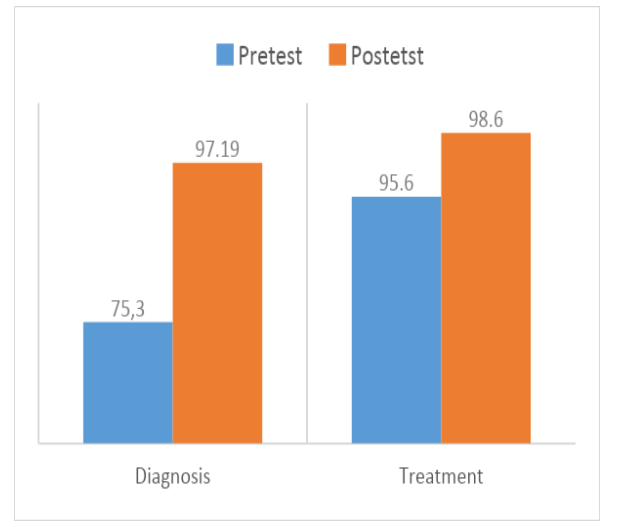
Figure 2: Pretest and post test score for diagnosis and treatment for acute scrotum.
In the urosepsis knowledge, there was a significant difference between pre-test and post-test for diagnosis, treatment, SIRS, and QSOFA knowledge with p<0.001; p=0,029; p<0.001; p<0.001, respectively (Figure 3). Similarly, the urinary retention topic, it also showed a significant difference between pre and post-test for urinary retention diagnosis topic (p<0.001) but not so in the treatment sub-topic (p=0.434) (Figure 4).
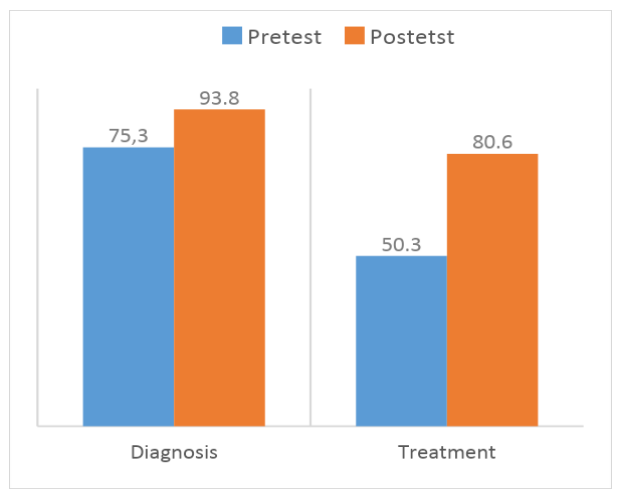
Figure 3: Pretest and post test score for diagnosis and treatment for urinary retention, SIRS, QSOFA.
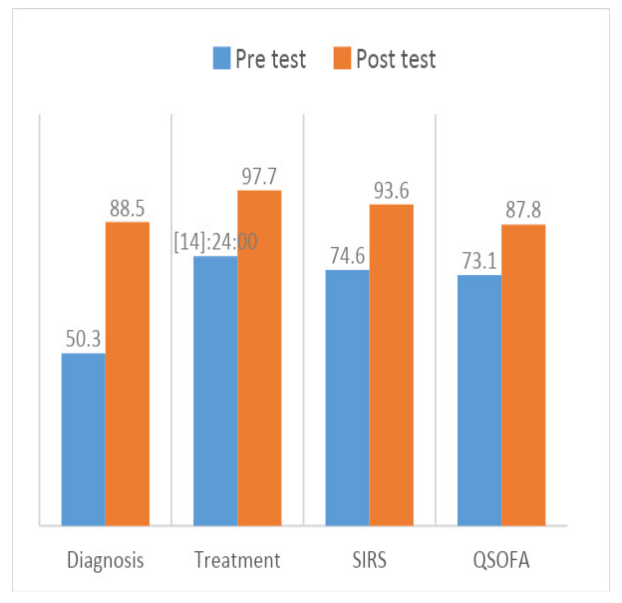
Figure 4: Pretest and post test score for diagnosis and treatment for urinary retention.
In the ureteral colic topic, the comparison between pre and post- test of diagnosis and treatment for ureteral colic showed significant difference with p<0.001 (Figure 5).
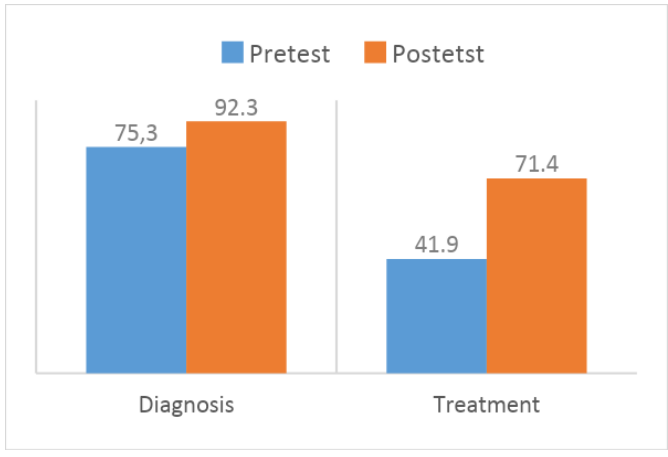
Figure 5: Pretest and post test score for diagnosis and treatment for ureteral colic.
The relationship between year of graduation and posttest score was analyzed further with Kruskal-Wallis test and significant differences were found between each group of graduation year. The group of 2018 graduation was statistically found to get the highest scores, meanwhile the least was gained by the ungraduated group (p=0.046) (Table 2).
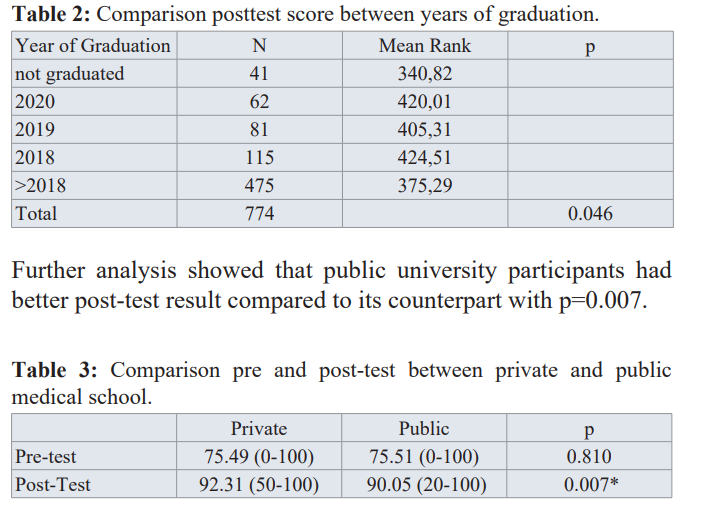
Discussion
The COVID-19 pandemic has shifted in-person education to E-learning and webinars. This survey study aimed to evaluate the effectiveness of non-traumatic urological emergencies education to medical personnel using recently implemented web-based education [7]. From the evaluation in this study, it is clear that the overall result was significantly different between pre and post-test score with the average result of pre-test score of 75,4% versus 91,3% on post-test score. Acute scrotum, as one of the topics presented on the webinar, had significant effectiveness to be transferred with the new learning method. This is a positive finding since the knowledge on how to diagnose and treat acute scrotum is very important to general practitioners. One of the most common causes of the acute scrotum is testicular torsion [7]. From the questions about diagnosis and treatment of testicular torsion on the acute scrotum topic, there was a significant difference in the number of correct answers between pre and post-test. This is evidence of webinar as an effective method to improve the medical personnel's knowledge on acute scrotum during COVID-19 pandemic situations. It was similar to other research results that web-based education is effective in the education process during the COVID-19 pandemic situation [8].
Urosepsis is a sepsis caused by urogenital tract infection [9]. In this study, medical personnel's knowledge on urosepsis was assessed on its (1) diagnosis, (2) treatment, (3) Q-SOFA, and (4) SIRS parameters. Significant difference was found between pre and post-test scores of these four parameters, which means that webinar is an effective method to improve the medical personnel's knowledge on urosepsis during COVID-19 pandemic situation. This result was supported by meta-analysis that webinar tend to be more effective in highly educated participants (medical personnel) [10].
Urinary retention and ureteral colic are frequent urological emergencies, and has become a public health issue with the annual incidence of urinary tract stones in the industrialized world is estimated to be 0.2%. By giving more information about urinary retention and ureteral colic, improvement of the medical personnel's ability to diagnose and treat the patients is expected. This study found significant differences between pre and post-test scores, especially in the participants' ability to diagnose the cases. This result is similar to another study, which reported that webinar is effective to improve the knowledge on emergency cases [12].
Similarly, after the webinar, the participant can diagnose urinary retention properly, even though before that they cannot even distinguish between oliguria, anuria, and urinary retention. This showed a significant improvement of knowledge through webinar learning methods. The lowest score of the post-test group was found in ungraduated; this finding may be caused by lack of knowledge and experience in the ungraduated group regarding the topics explained by the lecturer.
This was contrary with the highest score of the post-test group; Participants that graduate in 2018 may get sufficient knowledge and enough time to experience the real case regarding the explained topics. A study also reported a similar result, that doctors with more experience have higher knowledge about emergency cases and have a better skill in the emergency field [13].
We also analyzed the posttest score between private and public university participants with the result being significantly different. Public university participants tend to have better basic knowledge about emergencies so that their posttest score is better than private university participants are. Furthermore, most of public medical schools in Indonesia have bigger teaching hospitals, had more patients compared to the private hospitals, which means participants from public medical schools had been exposed with more cases, and have more experience in emergency cases [14]. A previous study that analyzed the knowledge about emergency cases between graduated students from the public and private medical schools reported that doctors from public medical schools have more experience with emergency cases compared to the doctors from the private medical schools [14]. To help mitigate this difference, we need to adjust this intervention into group based discussion approach in order to classify whether public and private school group or merit-based group.
For certain topic (treatment for urinary retention), this method of education was not successful to impart knowledge. The ability to treat the urinary retention cases was not significant, because the participants had already known how to treat the urinary retention before and after the survey. The other method of webinar life transmission for the hospital depicting real life scenario can be implemented to impart knowledge [15].
Other webinar methods (for instance one to one webinar or group base webinar) can be alternative methods to improve knowledge. The advantage of live webinar life transmission for the hospital depicting real life scenario is the participant can relate to daily case in hospital.15
The webinar method is effective in this case because the educators were certified urologists. They are seasoned educators with more than 5 years of experience; therefore, they could professionally share their expertise to the participants during the webinar.
What Is Already Know In This Topic
- Providing medical information and education are becoming a new challenge in the COVID-19 pandemic situation. Many institutions try to overcome this problem by using the webinar as a solution.
- Some studies tried to analyze the effectiveness of the webinar as a tool to provide medical However, many of the studies only evaluate the usage of the webinar, for example, is it easy to use, or is it easy to understand the information given.
- Many studies only analyzed the outcome from the general topic and only evaluate the knowledge after the webinar.
What This Study Adds
- In this study, we used a specific topic of the webinar which was a non-traumatic urology emergency that consists of four sub- topics included the acute scrotum, urosepsis, urinary retention, and colic pain.
- We evaluate the outcome of the webinar using pre and post-test as a tool, so we can compare the level of knowledge before and after the webinar to know the effectiveness of the webinar for each sub-topics.
Take Home Message
- This pandemic should not be a barrier for us to keep learning and sharing knowledge.
- In this study, we suggest the webinar as a medium to provide information and education in the field of non-traumatic urology emergencies which showed a good outcome.
- The webinar is known as low budget medium, that can be accessed anywhere and anytime. Therefore, it is easy to keep update and keep learning during this pandemic.
Limitation
The study has several limitations. The first limitation of this study was we only evaluated the webinar once, right after the webinar finished. Therefore, we could not evaluate the participant's retention toward the topics given.
The other was we could not guarantee that each participant received the same standard of the topics because there were external variables that could affect this webinar included the participant's gadget, internet signal, and environment during the webinar.
Conclusion
Based on the results in this present study, webinar should be considered as one of alternatives to provide and share the knowledge about non-traumatic urology emergencies for medical personnel during COVID-19 Pandemic situations. However, this method is not recommended for well-known information.
References
- Kessler CS, Bauml J. Non-traumatic urologic emergencies in men a clinical review. Western Journal of Emergency Medicine. 2009; 10: 281.
- Rose Medical student education in the time of COVID-19. Jama. 2020; 323: 2131-2132.
- Li L, Xv Q, Yan COVID-19 the need for continuous medical education and training. The Lancet Respiratory Medicine. 2020; 8: e23.
- Mian A, Kha S. Medical education during pandemics a UK perspective. BMC medicine. 2020; 18: 1-2.
- Moszkowicz D, Duboc H, Dubertret C, et al. Daily medical education for confined students during COVID-19 pandemic A simple videoconference solution. Clinical Anatomy. 2020; 33: 927-928.
- Reinholz M, French LE. Medical education and care in dermatology during the SARS-CoV2 pandemia challenges and Journal of the European Academy of Dermatology and Venereology. 2020; 34: 3214-e216.
- Williams M, Barclay Y, Harper L, et al. Feasibility acceptability and cost efficiency of using webinars to deliver first-line patient education for people with Irritable Bowel Syndrome as part of a dietetic-led gastroenterology service in primary care. Journal of Human Nutrition and Dietetics. 2020; 33: 758-766.
- Wagenlehner FM, Lichtenstern C, Rolfes C, et al. Diagnosis and management for urosepsis. Int J of Urology. 2013; 20: 963-970.
- Gegenfurtner A, Ebner C. Webinars in higher education and professional training a meta-analysis and systematic review of randomized controlled trials. Educational Research Review. 2019; 28: 100293.
- Ding M, Wang Y, Braga LH, et al. Urology education in the time of COVID-19. Canadian Urological Association 2020; 14.
- Alnabelsi T, Al-Hussaini A, Owens D. Comparison of traditional face-to-face teaching with synchronous e learning in otolaryngology emergencies teaching to medical undergraduates a randomised controlled trial. European Archives of Oto-Rhino-Laryngology. 2015; 272: 759-763.
- Filgueiras Filho NM, Bandeira AC, Delmondes T, et al. Assessment of the general knowledge of emergency physicians from the hospitals of the city of Salvador Brazil on the care of cardiac arrest Arquivos brasileiros de cardiologia. 2006; 87: 634-640.
- http://www.arspi.org/rumah-sakit-anggota-arspi/
- Moura FS, Carvalho FVD, Vasconcelos GM, et Knowledge of guidelines for cardiopulmonary resuscitation among Brazilian medical students. Revista Brasileira de Educação Médica. 2016; 40: 77-85.
- Wiecha J, Heyden R, Sternthal E, et Learning in a virtual world experience with using second life for medical education. Journal of medical Internet research. 2010; 12: e1.